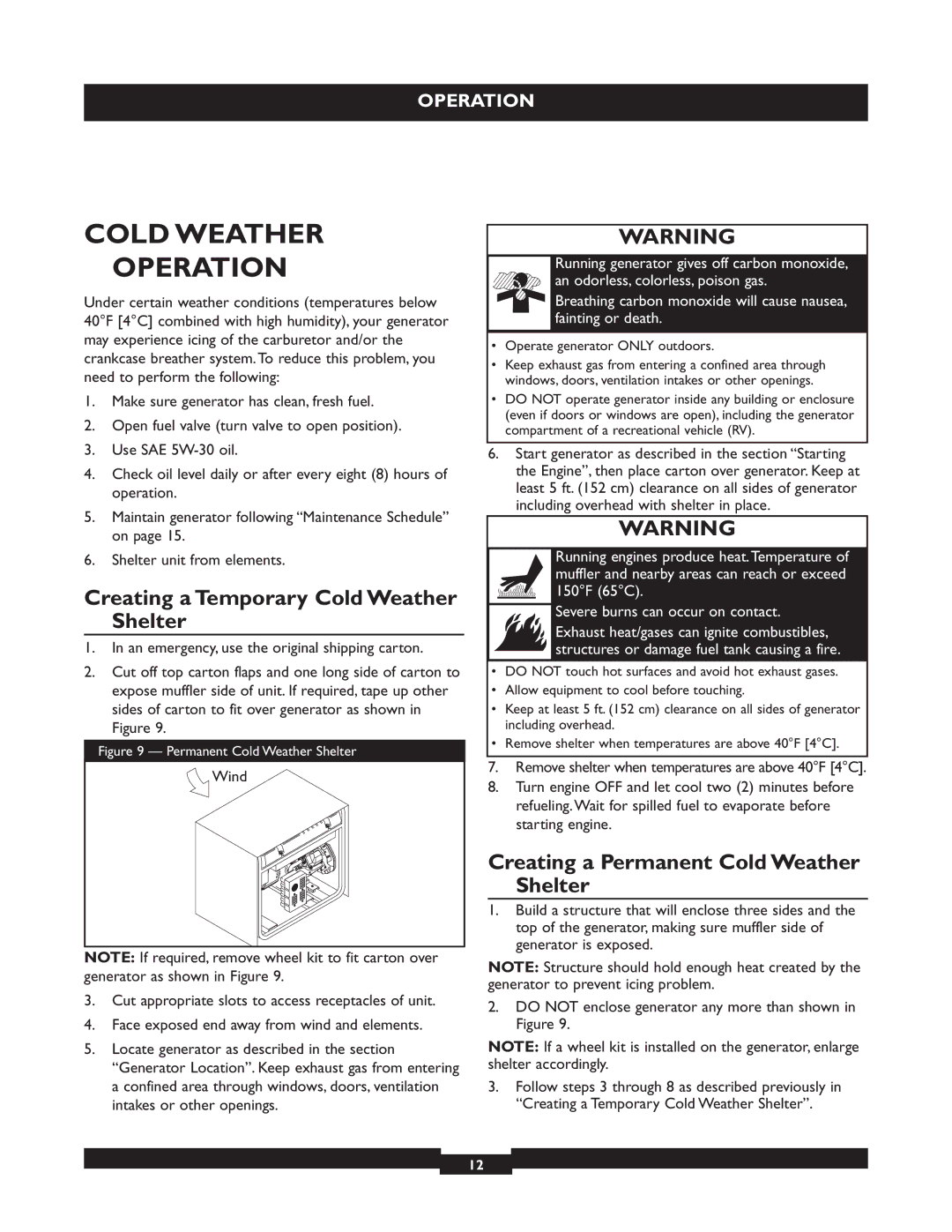Starting Watts
Model / Modèle / Modelo
Table of Contents
Safety Rules
Equipment Description
When Adding or Draining Fuel
When Starting Equipment
When Operating Equipment
When Transporting or Repairing Equipment
When Adjusting or Making Repairs to Your Generator
When Testing for Engine Spark
Know Your Generator
Hour Meter Fuel Tank
Assembly
Before Starting the Engine
Unpacking the Generator
Add Engine Oil
When Adding Fuel
Add Fuel
Type of Fuel
High-altitude use
Using the Generator
Connecting to a Building’s Electrical System
System Ground
Generator Location
Operating Generator
Starting the Engine
Connecting Electrical Loads
Receptacles
Stopping the Engine
120/240 Volt AC, 20 Amp Locking Receptacle
Ground Fault Protection
Testing the Gfci
Generator Adapter Cord SET
Volt AC, 15 Amp, Gfci Duplex Receptacles
Cold Weather Operation
Creating a Temporary Cold Weather Shelter
Creating a Permanent Cold Weather Shelter
Power Management
Dont Overload Generator
Capacity
Example
Product Specifications
Power Ratings
Generator Specifications
Engine Specifications
Generator Maintenance
Generator Cleaning
General Recommendations
Engine Maintenance
Servicing Air Cleaner
Oil
To service the air cleaner, follow these steps
Changing Engine Oil
Servicing Spark Plug
Servicing Spark Arrester
Clean Cooling System
Carburetor Adjustment
Clean and inspect the spark arrester as follows
Storage
Long Term Storage Instructions
Protect Fuel System
Generator
Troubleshooting
Page
Emissions Control System Warranty
Owner’s Warranty Responsibilities
Page
Page
Limited Warranty
Veuillez Conserver CES Instructions
Table DES Matières
Description DE L Équipement
Règles DE Sécurité
Lors DE Lajout OU DE LA Vidange DU Carburant
Lors DU Démarrage DE Léquipement
Lorsque Léquipement Fonctionne
Lorsque Vous Transportez OU Réparez Léquipement
Lorsque Vous Réglez OU Réparez Votre Génératrice
Lors DE Tests Dallumage DU Moteur
Connaissez Votre Génératrice
Bouchon de remplissage dhuile Ajoutez de lhuile au
Prise double Gfci de 120 volts C.A., 15 ampères
Assemblage
Avant LE Démarrage DU Moteur
Ajoutez de lhuile à moteur
Enlever le génératrice de la boite
Ajoutez de lessence
Lors DE Lajout DU Carburant
Type d’essence
Utilisation à hautes altitudes
Utilisation DE LA Génératrice
Mise à la terre du système
Exigences spéciales
Dégagement de la génératrice
Utilisation DU Génératrice
Démarrage du Moteur
Poussez linterrupteur ON/OFF sur On . Interrupteur ON/OFF
Prises DE Courant
Branchement des Charges Électriques
Arrêt du Moteur
Prise à Verrouillage de 120/240 Volts c.a., 20 Ampères
Téléphonez à un centre de service de votre région
LA Série DE Corde Dadaptateur DE Génératrice
Prise double Gfci de 120 Volts C.A., 15 Ampères
Fonctionnement PAR Temps Froid
Création d’un abri temporaire
Création d’un abri permanent
NE PAS Surchargez Génératrice
Capacité
Gestion de la Consommation
Exemple
Renseignements Techniques SUR LE Moteur
Caractéristiques DU Produit
Caractéristiques de la génératrice
Puissance nominale
Recommandations Générales
Entretien DE Génératrice
Nettoyage de génératrice
Utilisez un aspirateur pour ramasser les saletés et débris
Entretien DU Moteur Avertissement
Huile
Entretien du filtre à air
Vidange de lhuile moteur
Entretien de la bougie dallumage
Entretien du pare-étincelles
Pour faire lentretien du filtre à air, procédez comme suit
Nettoyer le système de refroidissement
Réglage du carburateur
Nettoyez et inspectez le pare-étincelles comme suit
Écran p are-étincelles
Entreposage
Entreposage À Long Terme
Générateur
Autres Idées de Remisage
Dépannage
Remarques
Garantie DU Dispositif Antipollution
Page
Remarques
Période DE Garantie
Garantie Limitée
Tabla DE Contenidos
Descripción DEL Equipo
Reglas DE Seguridad
Advertencia
Cuando Añada Combustible O Vacíe EL Depósito
Cuando Ponga EN Funcionamiento EL Equipo
Cuando Opere EL Equipo
Cuando Transporte O Repare EL Equipo
Precaución
Cuando Ajuste O Haga Reparaciones a SU Generador
Cuando Pruebe LA Bujía DEL Motor
Conozca SU Generador
Interruptor Balancín
Culatazo el Principio
Tomacorriente Gfci Dobles de 120 Voltios AC, 15 Amp
Montaje
Antes DE Darle Arranque AL Motor
Desembalaje del Generador
Agregar Aceite al Motor
Agregue Combustible
Cuando Añada Combustible
Tipo de combustible
Uso en grandes altitudes
USO DEL Generador
Tierra del Sistema
Conexión al Sistema Eléctrico de un Edificio
Ubicación del Generador
Operando EL Generador
Encienda el Motor
Receptáculos
Conexion De Cargas Electricas
Parado Del Motor
120/240 Voltios AC, 20 Amperios, Receptáculo de Seguridad
Juego DE Cables DEL Adaptador DEL Generador
Protección Contra Fallos de Conexión a Tierra
Comprobación del Gfci
Operación Durante UN Clima Frío
Figura 39 Clima Frío Estructura de Protección
No Sobrecargue Generador
Capacidad
Control de la Energía
Ejemplo
Información Técnica Sobre EL Motor
Especificaciones DEL Producto
Potencia Nominal
Especificaciones del Generador
Recomendaciones Generales
Mantenimiento DEL
Generador
Limpieza del Generador
Mantenimiento DEL Motor Advertencia
Aceite
Servicio del Depurador de Aire
Cambio de Aceite del Motor
Limpie/Reemplace la Bujía
Limpie la Pantalla Apagachispas
Para revisar el filtro de aire, siga estos pasos
Sistema de Refrigeración de Aire
Ajuste del Carburador
Limpie e inspeccione el apagachispas de la siguiente manera
Limpieza
Almacenamiento
Almacenamiento Para Periodos Prolongados
Proteja el Sistema de Combustible
Generador
Problemo Causa Accion
Diagnositicos DE Averías
Notas
Garantía DEL Sistema DE Control DE Emisiones
= 250 horas, B = 500 horas y a = 1000 horas
Uso del consumidor
Uso comercial

